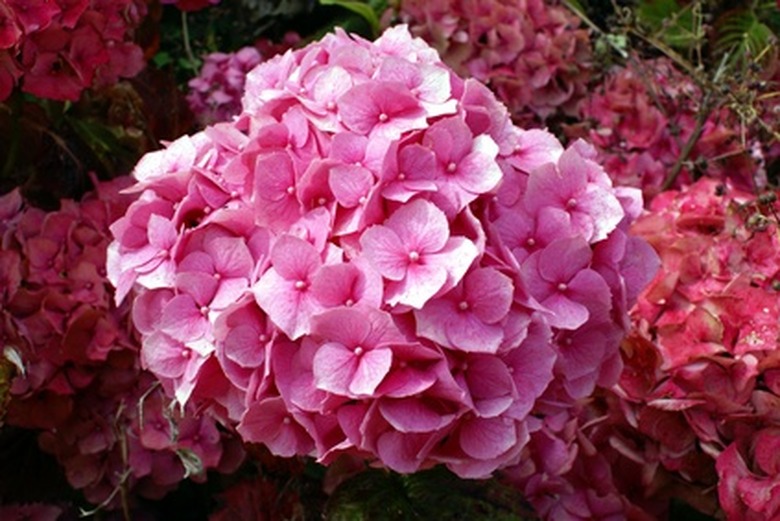Hardiness Zone For Hydrangeas
The term "hardiness zone" refers to the climate or areas in which a specific plant will grow well. These areas are given numbers by the U.S. Department of Agriculture (USDA). They are ranked according to the area's average minimum low temperatures. The higher the number, the hotter the climate. USDA plant hardiness zones 10 and 11, for example, are tropical areas of the country and rarely, if ever, dip below freezing. Hydrangeas vary only slightly in their hardiness zone requirements, depending on the species.
Types
There are 23 species in the Hydrangea genus, but only five are commonly cultivated in the United States, according to the U.S. National Arboretum. They are the bigleaf hydrangea (Hydrangea macrophylla), the climbing hydrangea (H. anomala), the smooth hydrangea (H. arborescens), the oakleaf hydrangea (H. quercifolia) and the panicle hydrangea (H. paniculata).
- The term "hardiness zone" refers to the climate or areas in which a specific plant will grow well.
- USDA plant hardiness zones 10 and 11, for example, are tropical areas of the country and rarely, if ever, dip below freezing.
Temperate Climates
All five of the common hydrangea species grow well in the mild, temperate climates of USDA zones 6 and 7. These climates have warm summers and cool winters, with wet weather particularly in the spring and fall. This ensures that the soil remains cool and moist, which allows hydrangeas to thrive. The average minimum temperatures in these zones is -10 degrees F in zone 6 and 10 degrees F in zone 7.
Cold Zones
Some hydrangeas are cold-hardier than others. The panicle hydrangea can tolerate cold zones better than all the others, according to Ohio State University. This hydrangea is cold-hardy to USDA zone 3, which has an average minimum temperature of -35 degrees F. This zone extends to parts of Montana, Wisconsin, Minnesota and even parts of Alaska. Smooth and climbing hydrangeas are cold-hardy to USDA zone 4 (average minimum temperatures of -25 degrees F), which includes parts of Minnesota, Montana and Nebraska. The oakleaf hydrangea tolerates cold temperatures in zone 5, which has an average minimum temperature of -15 degrees F and includes parts of Iowa, Illinois, Missouri and Pennsylvania.
- All five of the common hydrangea species grow well in the mild, temperate climates of USDA zones 6 and 7.
- This hydrangea is cold-hardy to USDA zone 3, which has an average minimum temperature of -35 degrees F. This zone extends to parts of Montana, Wisconsin, Minnesota and even parts of Alaska.
Hot Zones
Oakleaf, bigleaf and smooth hydrangeas can all tolerate the hot temperatures of USDA zone 9, which have an average minimum temperature of 25 to 30 degrees F. This zone extends to the northern parts of Texas and Florida. Climbing hydrangeas can only tolerate the warm temperatures of zone 7, while panicle hydrangeas can grow well in the heat of USDA zone 8.
Adaptability
The panicle hydrangea is the most adaptable of all the hydrangeas when it comes to hardiness zones. This hydrangea, which features creamy-white panicles (long, tapered flower spikes), can thrive in USDA zones 3 through 8, according to Ohio State Univesity. Bigleaf and climbing hydrangeas are the least adaptable. Bigleaf hydrangeas are picky about the moisture in the soil and only grow well in zones 6 through 9. Climbing hydrangeas do not like the heat and only grow well in zones 4 through 7.
- Oakleaf, bigleaf and smooth hydrangeas can all tolerate the hot temperatures of USDA zone 9, which have an average minimum temperature of 25 to 30 degrees F. This zone extends to the northern parts of Texas and Florida.
